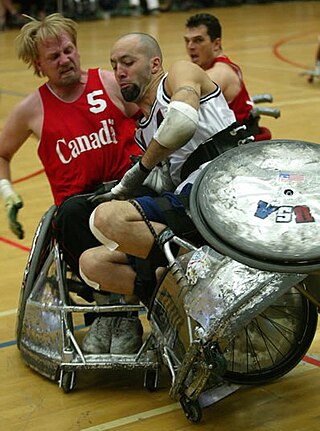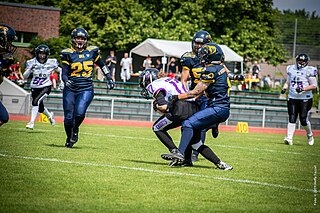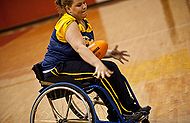
Canadian football, or simply football, is a sport in Canada in which two teams of 12 players each compete on a field 110 yards (101 m) long and 65 yards (59 m) wide, attempting to advance a pointed oval-shaped ball into the opposing team's end zone.

In gridiron football, a lateral pass or lateral occurs when the ball carrier throws the football to a teammate in a direction parallel to or away from the opponents' goal line. A lateral pass is distinguished from a forward pass, in which the ball is thrown forward, towards the opposition's end zone. In a lateral pass the ball is not advanced, but unlike a forward pass a lateral may be attempted from anywhere on the field by any player to any player at any time.

Touch football is an amateur variant of American football and Canadian football. The basic rules are similar to those of the mainstream game, but to end a down, the person carrying the ball need only be touched, instead of tackled, by a member of the opposite team. This rule change gave the game its name, to differentiate it from other variants. It is similar to street football, another amateur variant, however in street football full contact is allowed.

Wheelchair rugby is a team sport for athletes with a disability. It is practiced in over twenty-five countries around the world and is a summer Paralympic sport.

Gridiron football, also known as North American football, or in North America as simply football, is a family of football team sports primarily played in the United States and Canada. American football, which uses 11 players, is the form played in the United States and the best known form of gridiron football worldwide, while Canadian football, which uses 12 players, predominates in Canada. Other derivative varieties include arena football, flag football and amateur games such as touch and street football. Football is played at professional, collegiate, high school, semi-professional, and amateur levels.
This is a glossary of terms used in Canadian football. The Glossary of American football article also covers many terms that are also used in the Canadian version of the game.
- Legally positioned at the kick-off or the snap. On kick-offs, members of the kicking team must be behind the kick-off line; members of the receiving team must be at least 10 yards from the kick-off line. On scrimmages, at the snap the offence must be behind the line of scrimmage; the defence must be at least one yard beyond the line of scrimmage.
- A player of the kicking team who can legally recover the kick. The kicker and any teammates behind the ball at the time of the kick are onside. Thus on kick-offs all players of the kicking team are onside, but on other kicks usually only the kicker is. The holder on a place kick is not considered onside.
- A defensive position on scrimmages, also called free safety. Typical formations include a single safety, whose main duty is to cover wide receivers. See also defensive back.
- A two-point score. The defence scores a safety when the offence carries or passes the ball into its own goal area and then fails to run, pass, or kick the ball back into the field of play; when this term is used in this sense, it is also referred to as a safety touch.

American and Canadian football are gridiron codes of football that are very similar; both have their origins partly in rugby football, but some key differences exist between the two codes.

Gameplay in American football consists of a series of downs, individual plays of short duration, outside of which the ball is or is not in play. These can be plays from scrimmage – passes, runs, punts or field goal attempts – or free kicks such as kickoffs and fair catch kicks. Substitutions can be made between downs, which allows for a great deal of specialization as coaches choose the players best suited for each particular situation. During a play, each team should have no more than 11 players on the field, and each of them has specific tasks assigned for that specific play.

In American football and Canadian football, a quarterback kneel, also called taking a knee, genuflect offense, kneel-down offense, or victory formation, occurs when the quarterback touches a knee to the ground immediately after receiving the snap, thus downing himself and ending the play. It is primarily used to run the clock down, either at the end of the first half or the game itself, to preserve a lead or ensure a game goes into overtime if the game is tied and in the fourth quarter. Although it generally results in a loss of some yardage and uses up a down, it minimizes the risk of a fumble, which would give the other team a chance at recovering the ball.
Power Hockey also known as Powerchair Hockey is a competitive, fast-paced hockey game based on the use of a power wheelchair. The foundation of the sport derives from ice hockey and floor hockey, but with adapted rules to enable people with disabilities, who use a power wheelchair, to play and be active in a competitive team setting. The sport is also referred to as Electric Wheelchair Hockey or Electric Wheelchair Floorball in various parts of the world.

A comparison of American football and rugby union is possible because of the games' shared origins, despite their dissimilarities.
A comparison between American football and rugby league is possible because of their shared origins and similar game concepts. Rugby league is arguably the most similar sport to American football after Canadian football: both sports involve the concept of a limited number of downs/tackles and scoring touchdowns/tries takes clear precedence over goal-kicking.

High school football, also known as prep football, is gridiron football played by high school teams in the United States and Canada. It ranks among the most popular interscholastic sports in both countries, but its popularity is declining, partly due to risk of injury, particularly concussions. According to The Washington Post, between 2009 and 2019, participation in high school football declined by 9.1%. It is the basic level or step of tackle football.

Powerchair football, also known as Power Soccer, is a variant of association football for people with physical disabilities. Players use specially designed powered wheelchairs in order to maneuver and kick/hit an oversized football. The game is played in a gymnasium on a regulation basketball court. Two teams of four players use powerchairs equipped with footguards to attack, defend, and spin-kick a 13-inch (330 mm) football in an attempt to score goals.
Wheelchair soccer is a variation of association football, in which all of the participants are wheelchairs users due to physical disability. Intellectual disabilities can also be a factor, but this is not always the case. The wheelchairs can be either motorised, or manually pushed.
Variations of Australian rules football are games or activities based on or similar to the game of Australian rules football, in which the player uses common Australian rules football skills. They range in player numbers from 2 up to the minimum 38 required for a full Australian rules football.
The following terms are used in American football, both conventional and indoor. Some of these terms are also in use in Canadian football; for a list of terms unique to that code, see Glossary of Canadian football.

American football, also known as gridiron football, is a team sport played by two teams of eleven players on a rectangular field with goalposts at each end. The offense, the team with possession of the oval-shaped football, attempts to advance down the field by running with the ball or throwing it, while the defense, the team without possession of the ball, aims to stop the offense's advance and to take control of the ball for themselves. The offense must advance at least ten yards in four downs or plays; if they fail, they turn over the football to the defense, but if they succeed, they are given a new set of four downs to continue the drive. A game is won by the team with the higher number of points, which are scored primarily by advancing the ball into the opposing team's end zone for a touchdown or kicking the ball through the opponent's goalposts for a field goal.
A comparison of Canadian football and rugby union is possible because of the games' shared origins, despite their dissimilarities.














